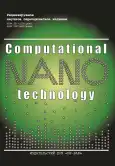Модели масштабирования электрических свойств фото- и бета-преобразователей с наногетеропереходами
- Авторы: Долгополов М.В.1,2, Елисов М.В.1, Раджапов С.А.3, Чипура А.С.1
-
Учреждения:
- Самарский национальный исследовательский университет имени академика С.П. Королева
- Самарский государственный технический университет
- Физико-технический институт Научно-производственного объединения «Физика-Солнце» Академии наук Республики Узбекистан
- Выпуск: Том 10, № 1 (2023)
- Страницы: 138-146
- Раздел: НАНОТЕХНОЛОГИИ И НАНОМАТЕРИАЛЫ
- URL: https://bakhtiniada.ru/2313-223X/article/view/250560
- DOI: https://doi.org/10.33693/2313-223X-2023-10-1-138-146
- ID: 250560
Цитировать
Аннотация
Предложена методология и рассмотрено компьютерное моделирование масштабирования электрических свойств наночипов-генераторов полупроводникового преобразователя энергии на основе наноразмерных контактных гетеропереходов для обеспечения максимальной мощности. Вариант оптимизации решения масштабирования представляется соединением наногетеропереходов с увеличением плотности тока неравновесных носителей и напряжения холостого хода. Представлена обобщенная эквивалентная схема для различных вариаций внутренних свойств и идентификации экспериментальных данных. Проанализировано влияние вида масштабирования и параметров моделей.
Ключевые слова
Полный текст
Открыть статью на сайте журналаОб авторах
Михаил Вячеславович Долгополов
Самарский национальный исследовательский университет имени академика С.П. Королева; Самарский государственный технический университет
Email: mikhaildolgopolov68@gmail.com
ORCID iD: 0000-0002-8725-7831
кандидат физико- математических наук, доцент; доцент кафедры высшей математики Самарского государственного технического университета; заведующий совместной с РАН научно- исследовательской лабораторией математической физики, доцент кафедры общей и теоретической физики Самарского национального исследовательского университета имени академика С.П. Королева
Россия, Самара; СамараМаксим Вячеславович Елисов
Самарский национальный исследовательский университет имени академика С.П. Королева
Email: maksimelisov2003@gmail.com
ORCID iD: 0009-0001-3097-2703
студент Самарского национального исследовательского университета имени академика С.П. Королева
Россия, СамараСали Аширович Раджапов
Физико-технический институт Научно-производственного объединения «Физика-Солнце» Академии наук Республики Узбекистан
Email: rsafti@mail.ru
ORCID iD: 0000-0002-4615-027X
доктор физико-математических наук; главный научный сотрудник лаборатории «Полупроводниковые высокочувствительные датчики» Физико-технического института Научно-производственного объединения «Физика-Солнце» Академии наук Республики Узбекистан
Узбекистан, ТашкентАлександр Сергеевич Чипура
Самарский национальный исследовательский университет имени академика С.П. Королева
Автор, ответственный за переписку.
Email: al_five@mail.ru
ORCID iD: 0009-0004-0425-0653
магистрант Самарского национального исследовательского университета имени академика С.П. Королева
Россия, СамараСписок литературы
- Имамов Э.З., Муминов Р.А., Рахимов Р.Х. Анализ эффективности солнечного элемента с наноразмерными гетеропереходами // Computational Nanotechnology. 2021. Т. 8. № 4. С. 42–50.
- Haken H. Synergetics. Berlin-Heidelberg: Springer, 1977.
- Shchukin V.A., Ledentsov N.N., Kopev P.S., Bimberg D. Spontaneous ordering of arrays of coherent strained islands // Phys. Rev. Lett. 1995. Vol. 75. No. 16. Pp. 2968–2971.
- Леденцов Н.Н., Устинов В.М., Иванов С.В. и др. Упорядоченные массивы квантовых точек в полупроводниковых матрицах // УФН. 1996. Т. 166. № 4. С. 423–428.
- Имамов Э.З., Муминов Р.А., Рахимов Р.Х. и др. Моделирование электрических свойств солнечного элемента с многими наногетеро-переходами // Computational Nanotechnology. 2022. Т. 9. № 4. C. 70–77.
- Чепурнов В.И., Раджапов С.А., Долгополов М.В. и др. Задачи определения эффективности для микроструктур SiC*/Si и контактообразования // Computational Nanotechnology. 2021. № 3. С. 59–68.
- Долгополов М.В., Чепурнов В.И., Пузырная Г.В. и др. Экспериментальное исследование полупроводниковых структур источника питания на углероде-14 // Физика волновых процессов и радиотехнические системы. 2019. Т. 22. № 3. С. 55–67.
- Физика полупроводниковых преобразователей / под ред. акад. РАН, проф. А.Н. Саурова, чл.-корр. АН Татарстана, проф. С.В. Булярского. М.: РАН, 2018. 280 с.
- Раджапов С.А., Раджапов Б.С., Джанклич М. и др. Полупроводниковые детекторы ядерного излучения на основе гетеропереходных структур Al–αGe–pSi–Au для измерения малоинтенсивных ионизирующих излучений // Computational Nanotechnology. 2018. № 3, С. 65–67.
- Akimchenko A., Chepurnov V., Dolgopolov M. et al. Betavoltaic device in por-SiC/Si C-Nuclear Energy Converter // EPJ Web of Conferences. 2017. Vol. 158.
- Цой Б. Патент в Евразийском патентном ведомстве (EP2405487 A1. 08.30.2012).
- Цой Б. Патент во всемирной организации интеллектуальной собственности (№ WO 2011/040838 A2 07.04.2011).
- Пикус Г.Е. Основы теории полупроводниковых приборов М.: Наука, 1965. 448 с.
- Rawa M., Calasan M., Abusorrah A. et al. Single diode solar cells–improved model and exact current–voltage analytical solution based on Lambert’s W function // Sensors. 2022. No. 22. P. 4173.
- Гурская А.В., Долгополов М.В., Раджапов С.А., Чепурнов В.И. Контакты для SiC-преобразователей в диапазоне нано-микроватт // Вестн. Моск. ун-та. Сер. 3. Физ. Астрон. 2023. № 1. C. 2310103.
- Чепурнов В.И., Гурская А.В., Долгополов М.В., Латухина Н.В. Способ получения пористого слоя гетероструктуры карбида кремния на подложке кремния. Патент № 2653398, получен 18.05.2018, приоритет 19.07.2016.
- Долгополов М.В, Сурнин О.Л., Чепурнов В.И. Устройство генерирования электрического тока посредством преобразования энергии радиохимического бета-распада С-14. Патент РФ № 2714690, опубл. 19.02.2020. Бюл. № 5.
Дополнительные файлы














